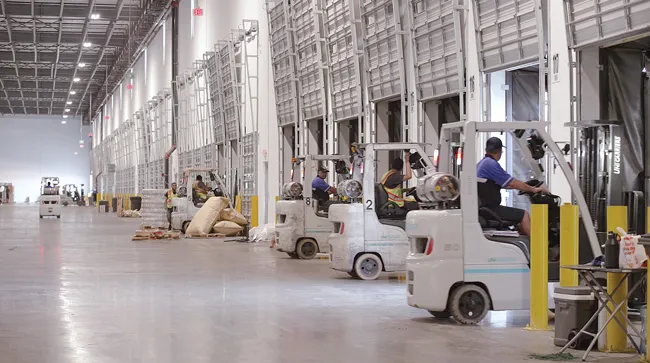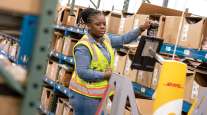Staff Reporter
Trucking, Logistics Experience Another Strong Holiday Season

[Stay on top of transportation news: Get TTNews in your inbox.]
The trucking and logistics sector is experiencing another strong holiday shipping season as consumer spending helps to counter the broader freight downturn.
The National Retail Federation expects holiday season retail sales to be between 2.5% and 3.5% over 2023. The industry association reported that a near-record 197 million people shopped between Thanksgiving and Cyber Monday. The DHL 2024 Peak Season Shipping Survey of small and medium-sized enterprises revealed 48% were expecting an increase in holiday sales over 2023.
“The story of this year’s holiday season started back in the spring,” said Noah Hoffman, vice president of retail logistics at C.H. Robinson Worldwide. “October is when retailers are normally bringing in merchandise from overseas to be ready for early Black Friday and Cyber Monday sales. But October also happened to be the deadline for a port strike.”
Hoffman added that some retailers planned ahead by pulling inventory forward as early as June. Because of that, the normal peak shipping season was stretched out longer than usual this year. C.H. Robinson ranks No. 2 on the Transport Topics Top 100 list of the largest logistics companies in North America.
“October was still seasonably robust for trucking because the port strike lasted only three days, front-loaded inventory still had to get from warehouses to its final destination, and some of our customers didn’t choose to front-load or couldn’t front-load,” Hoffman said. “For our customers moving seasonal items on a more traditional schedule, trucking capacity has been ample.”

C.H. Robinson employees operate forklifts at the company's facility in Laredo, Texas. (C.H. Robinson)
Hoffman added that a consequence of building inventory early is that retailers had less time to see what consumer trends might emerge.
“Despite all the negative expectations that we saw last year, or the year before, about the health of the U.S. consumer, I think this proves that the U.S. consumer is still in healthy shape,” said Mazen Danaf, staff applied scientist and economist at Uber Freight. “I’m sure you looked at these trends about how much consumers spend on online shopping during Black Friday and Cyber Monday. Both of these were at record levels.”
Danaf attributed the increase primarily to increased cargo as opposed to just an increase in costs. He pointed to a few reasons why consumer spending has remained strong: unemployment below expectations, robust real disposable income and continued consumer spending, bolstered by e-commerce.
Lori Heino-Royer of Waabi discusses the latest developments, breakthroughs and key industry partnerships in autonomous trucking. Tune in above or by going to RoadSigns.ttnews.com.
“We’re seeing some of the lowest delivery times we’ve really ever seen, so it’s looking strong,” said Jenna Slagle, senior data analyst at Project44. “We’ve made a full recovery since those COVID days. The industry has really adjusted to the increased volume that we see for the last-mile shipping, and it’s looking pretty good. We’re still seeing a bit of a dip, but I think that’s always going to happen when you have this kind of volume.”
Slagle added that companies have heavily invested in faster, more efficient order fulfillment since the pandemic, including building new distribution centers and warehouses while leveraging technology for tasks like route optimization. She said consistent volumes indicate that much of the pandemic-driven shift toward e-commerce remained after lockdowns ended.
“Every year we see this trend where the holiday season starts earlier and earlier,” said Pawan Joshi, executive vice president of products and strategy at E2open. “This time around it was attributed to there being five less days between the holiday shopping period. But I think the fact that it started early, we saw a lot of the shopping get distributed fairly evenly across the period other than the spikes around Cyber Monday.”
Joshi added that other factors pushed freight movement earlier than normal, like the port strike and uncertainty about the presidential election. Global supply chain bottlenecks also affected critical trade areas like the Suez Canal this year.
Want more news? Listen to today's daily briefing above or go here for more info
“Almost half of consumers report back that their largest concern during the holiday is delays,” said Dan Spitale, vice president of UPS Capital. “We see delays as the biggest of concerns, but we’re also looking at a new wave, if you will, in terms of being able to offer more robust shipping options.”
Spitale noted that the trend extends across the collective community of online buyers instead of just being centralized on one group. The upside is that customer demand for faster, more diverse shipping options reflects overall consumer strength.
“Retail sales expected to hit near $1.5 trillion, which is about a 5% increase year over year,” Spitale said. “Things are jumping off a little better than maybe some thought. Different industries and different verticals have different outputs, of course, and when you start talking about retail, it’s so overarching now, it’s not just the traditional retailers anymore. It’s the online marketplaces.”





